Table of Contents
Toggle7 Most Commonly Served Indian Fast Food Dishes
As soon as we move out for a break, the first thing we search for is a fast food vendor nearby. It’s quick, filling, tasty, budget friendly and the best thing about Indian fast food, they really connect people!
Whenever there’s a get together of friends or colleagues or family, food is always a popular topic of conversation. Being a foodie gives me an advantage during such discussions as I have a good knowledge about the different foods, cooking styles, and the ‘best of’ list. You can say I have a thing about food so I am keen on visiting and trying out new restaurants every now and then.
So let’s begin with knowing about the seven Indian fast food dishes that have made to the top of the list of favorites and find out what makes them so special.
All Time Favorite Indian Fast Food: Samosas
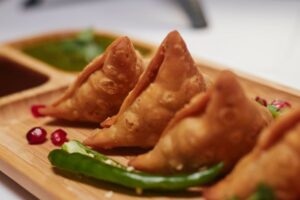
Most Indians consider samosas to be a simple street snack, but they are so much more.
Few people realize that the samosa, which is widely considered a uniquely Indian fast food dish, does not originate in India. That’s right, you read that correctly. The deep-fried, densely packed spicy delicacy we assumed came from India is actually a delectable and well-traveled Central Asian immigrant!
According to the legends, the stuffed triangle travelled from Central Asia to North Africa, East Asia, and South Asia courtesy to the travelling merchants of Middle East.
These fried treats, which are shaped like a triangle, are usually packed with potatoes or other vegetables. The filling is added, the dough is folded up, and the samosa is deep fried to a golden brown and served with a mint chutney after flour, ghee, and salt are mixed together to form a dough; after rolling and cutting into semi-circles, the filling is added, the dough is folded up, and the samosa is deep fried to a golden brown color and served hot with a mint chutney.
Click on the following link for recipe:
https://www.cookwithmanali.com/samosa-recipe/
Prince Of Indian Fast Food: Vada Pav (The Indian Burger)
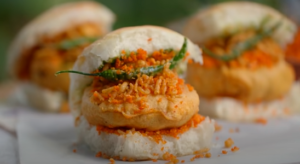
According to folklore, Ashok Vaidya, whose vada pav kiosk was located right outside Dadar station, invented the Mumbai sandwich.
It was inexpensive, simple to prepare, and easy to consume; all of these elements contributed to its popularity among those who did not have the time or leisure to eat during their long travels.
The vada used in the Indian fast food dish vada pav is created from cooked and mashed potatoes mixed with spices. Vendors frequently fried them ahead of time and set them aside. They place them on the pav and spread delightful coriander chutney on top, which is then served with green chilies and masala.
The first time I ate vada Pav, it was almost as if I was biting into the original taste of Mumbai as my teeth sank into the soft cloud of pav and the crispy vada. The chewy blandness of the pav acted as a foil to the spicy crunchiness of the vada, creating a great contrast of tastes and textures. The first bite this Indian fast food was a hot hit even for my palate, which had been formed by years of spicy meals.
Click on the following link for recipe:
https://www.vegrecipesofindia.com/vada-pav-how-to-make-wada-pav/
Indian Fast Food Queen: Pav Bhaji (Mumbai Style)
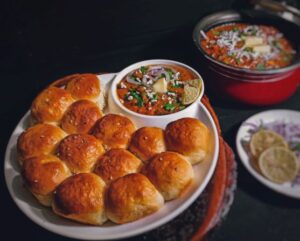
When was the last time you ate anything at a Mumbai street vendor’s and wondered about the dish’s origins? Well, while many people mistakenly attribute the dish’s roots to Gujarat, it was originally created as a necessity by the ladies of Mumbai’s chawls in the nineteenth century.
Pav Bhaji is maybe Mumbai’s most popular street Indian fast food dish, the first South Asian dish to be linked to the term “fast food.” A spicy, soupy, crunchy mixture of veggies, pan or Tawa fried in a unique mixture of spices, served along with two or three parts of the city’s famous laadi pavs, soaked in butter and chaat masala – this is a joy for any keen foodie.
Served with toppings ranging from mozzarella cheese to grated paneer to mushrooms, the modest Pav Bhaji, which was frequently served in stalls or small vendors in humble nooks and corners of the city, has now taken on a national and even international character. In some regions, it has even grown into Pav Bhaji pizzas as part of Indian fast food.
Click on the following link for recipe:
https://foodviva.com/snacks-recipes/pav-bhaji/
South Ka Indian Fast Food: Idli Sambhar
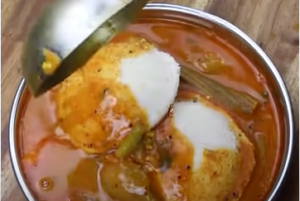
Idli is India’s favorite South Indian dish with a fascinating story. The Indonesian kedli, a fluffy steamed cake akin to the Indian idli, was the forerunner of the Indian idli. Idli is also said to be the variation of idada, which is a steamed white dhokla made with the same rice and urad dal as idli.
To those who are unfamiliar, this is a savoury rice cake produced by steaming a fermented rice and legumes mixture. Semolina can also be used to make idlis.
Idlis are a nutritious breakfast option. They are easily digested and can be consumed by both youngsters and adults.
According to legend, the original recipe for sambar, a delightful combination of lentils and vegetables, may be traced back to Maratha ruler Shivaji’s son, Sambhaji.
Sambhaji (a fantastic cook) loved spicy dal and decided to try tamarind pulp in it one day. The dish he prepared was served to the court, which praised it as a superb dinner. Sambhaji adored his own creation, and it was given the name sambar over time.
Sambar has had many variations over the years. Tamil Nadu sambar differs significantly from Karnataka sambar. Wet pastes are favored in Karnataka, while dry powders (podi) are utilized in Tamil Nadu.
Click on the following link for recipe:
https://www.indianhealthyrecipes.com/idli-sambar-recipe-tiffin-sambar/
Poha-Jalebi The Indori Indian Fast Food
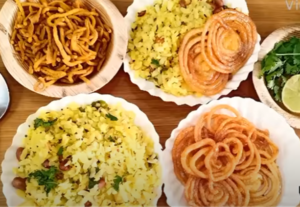
Have you ever pondered why a simple breakfast dish has become so popular in our society and what relates it to the city of Indore? A low-cost, filling meal, with a flavor of jalebi and served in no time is why it is always in demand. Poha with Jalebi sounds awkward but believe me ones you have it, you will never find poha complete without a jalebi! This is the special serving in Indore.
Well, Poha originated in Maharashtra, as it turns out. The colloquial dish gained significant popularity during the reigns of the Holkars and Scindias. When the kings of Maharashtra arrived in Madhya Pradesh, they seized Indore and brought Poha with them.
While it’s typically served with chopped onions, tomatoes, and a variety of spices in Maharashtra, Indore does things a little differently. Poha is topped with namkeens—the famed Indori sev—which adds a fresh texture and flavour to the entire flat rice-based dish.
Click on the following link for recipe:
https://www.indianhealthyrecipes.com/poha-recipe-kanda-batata-poha/
Chatt-Pati Indian Fast Food: Bhel Puri
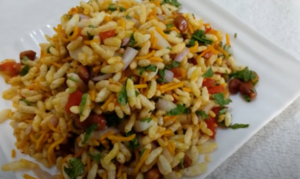
Bhel puri is a savory Indian snack prepared with puffed rice and vegetables mixed in tangy chutneys. It’s a quick and easy snack to make at home, and it’s typically served in paper cones at roadside shops. Bhelpuri is a sour and crunchy teatime snack that may be found in most Indian restaurants.
Bhel puri has a strong connection to Mumbai and is the most popular snack on the city’s beaches, such as Chowpati and Juhu. To give this Indian fast food a spicy flavour, tamarind or date chutneys are frequently utilized. In Mumbai, the meal is very popular as a beach snack or comfort food. Although there is no definitive date for the invention of bhelpuri, it is thought that the snack was created by an unnamed Gujarati migrant.
Click on the following link for recipe:
https://www.indianhealthyrecipes.com/bhel-puri/
Rainy Season Ka Raja Indian Fast Food: Bhajia (Pakoda)
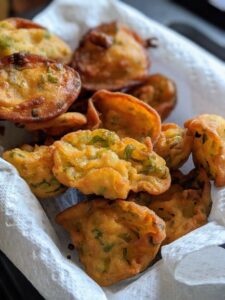
A steaming cup of tea and a plate of deep-fried pakodas are ideal for a wet day. The basic concept of this simple cuisine is the same all over the country. For foodies it’s a must have Indian fast food in the rainy season.
Pakoda, also known as pakora, pakodi, fakkura, bhajiya, bhaaja, bhajji, bhaji, or ponako, is a deep-fried snack (fritter) popular in several parts of India.
Pakoda literally translates to “deep-fried meal.” While it goes by a variety of names, the core description remains the same.
It refers to dough that has been deep-fried in ghee, seasoned with spices, and packed with vegetables or pulses.
Pakodas are simply sliced vegetables dipped in batter (typically chickpea flour) and deep-fried, or finely chopped veggies individually or mixed vegetables mixed in batter and deep-fried. They are a single concept that you may interpret in a thousand different ways!
Click on the following link for recipe:
https://www.indianhealthyrecipes.com/pakora-recipe-vegetable-pakora-pakoda/
Concluding
So now you can understand why these delectable foods are referred to as fast food. They are not just quick to prepare, but also the Indian equivalent of Western fast food. Each of these recipes is a staple of India’s thriving street food culture, with vendors all throughout the country making and selling them.
So now you can understand why these delectable foods are referred to as Indian fast food not just because they are quick to prepare, but also because they are the Indian equivalent of Western fast food. Each of these recipes is a staple of India’s thriving street food culture, with vendors all throughout the country making and selling them.







